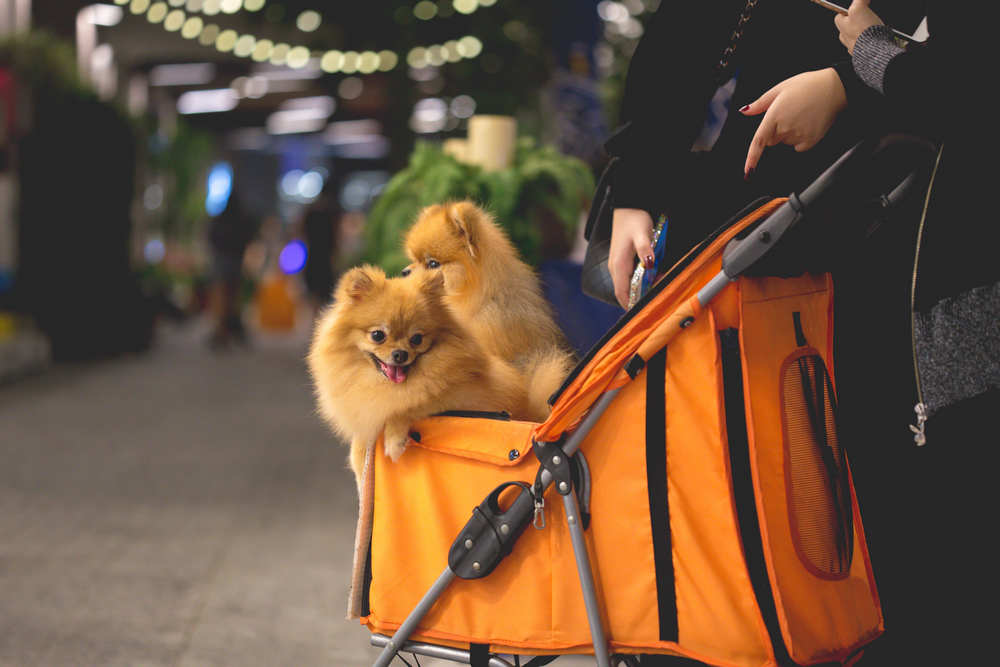How Can I Ship My Dog to Another State?
Moving never felt odd to me. My family was always on the go, and by the time I turned 18, I'd lived in three different cities across the country. However, shipping a pet - especially a dog - is an entirely different ball game. There’s a level of responsibility and emotional weight that comes with transporting a beloved animal from Point A to Point B. Whether you’re taking a job in another state, chasing a new adventure, or simply relocating to be closer to family, you’ll want to keep your furry friend safe and comfortable along the way.
How much will my move cost?
Let us help match you
Thank you!
Your movers will contact you shortly.

Written by: National Movers Team
NationalMovers team provides expert insights, mover comparisons, and practical resources to help you make informed moving decisions. Whether you need company reviews, relocation tips, or expert guidance, we’ve got you covered. Read more
Reviewed by: Jason Walker
Jason Walker is a moving expert with personal and professional experience, sharing tips, guides, and reviews to make your relocation stress-free. Read more
Last Update: 03/09/2025
I’ve dealt with many moves, both personally and professionally. I started my career in freight logistics but soon found my calling helping people navigate tricky relocations. These days, I write for National Movers, an aggregator site that brings together moving companies and resources for folks across America. My sister, Megan – an amazing photographer and mother of four – has moved so frequently that she jokes about having membership points with every major moving company. In all that chaos, shipping her dog has always been top priority. So I know how critical it is to get this right.
Before we roll up our sleeves and look at the details, let’s take a moment to highlight an essential truth: there’s no one-size-fits-all approach for moving a pet. Different methods come with their own pros and cons. The goal is to find one that fits your dog’s temperament, your budget, and your timeline. And hey, if I sound like a concerned friend, it’s because I am. I’ve helped countless relatives and buddies relocate their pets, so I’m here to offer the same care to you.
Consider Your Dog’s Specific Needs – Factor in health, age, breed restrictions, and anxiety level to decide on the best travel method (driving, flying, pet transport, or train/bus).
Prepare Thoroughly – Crate-train your dog, pack essentials (food, meds, comfort items), and get any required vet checkups or paperwork before the trip.
Compare Costs & Convenience – Driving offers more control, flying is faster but requires strict adherence to airline rules, and professional pet transport can handle logistics (for a higher price).
Prioritize Comfort & Safety – Keep routines, schedule breaks, and ensure a secure, well-ventilated crate or carrier. A calm dog makes for a smoother move overall.
Best Overall Value Best Overall Value

- Nationwide availability
- Clear pricing, no hidden fees
- Premium door-to-door service
Need Help? Call Now
855-930-4574- Nationwide availability, over 25 years of experience, premium door-to-door service

- Reliable moving & Storage solutions
- Top-quality services, trained staff
- Reliable moving & Storage solutions, top-quality services, trained staff
Considerations Before Shipping Your Dog
A dog isn’t just another piece of luggage. It’s a living, breathing family member who can’t exactly voice concerns about cramped quarters or loud noises. The first step is to weigh several important factors.
- Health and Age: An older dog or one with certain medical conditions might need more attentive care. A quick chat with your veterinarian can set you on the right path.
- Breed Restrictions: Some airlines have rules about snub-nosed breeds like Pugs or Bulldogs because of potential respiratory issues. Overland travel can be more forgiving, but still double-check any regulations.
- Behavior and Anxiety: Not all pups are calm travelers. Some dogs might show stress by whining, scratching, or even nipping. Recognizing your dog’s comfort level is key.
- Budget: Costs vary widely, from fuel and lodging for a road trip to higher airfare or specialized pet-transport services. Being aware of these expenses upfront helps you plan effectively
Ultimately, you know your dog better than anyone else. If your buddy is anxious, consider a less stressful travel option. If your dog is a go-with-the-flow type, you might have more freedom in your choice. Either way, these points lay the foundation for a safe move.
Methods to Ship Your Dog to Another State

There’s more than one road leading to your new home, and the same is true for shipping your pet. Some folks load up the family car and make a big adventure out of it. Others schedule a flight. Some prefer professional pet transport, while a few find that train or bus travel works best.
1. Driving Your Dog
Why consider driving? For many dog owners, a road trip is the most comforting option. You’re in control, and your pet has a familiar face (or faces) along for the ride. I once drove a rescue Labrador from Austin, Texas, to Chicago with my wife, two toddlers, and a trunk full of peanut butter treats. Was it chaotic? Absolutely. But it gave me peace of mind knowing my dog was by my side the whole time.
Driving your dog can also turn into a mini-vacation. You’ll have the freedom to stop at scenic rest areas, dog-friendly motels, and roadside diners with the world’s best milkshakes. However, the downside is that you’ve got to handle all the logistics – fuel, hotel stops, dog-friendly pit stops – and you’ll likely spend more time on the road.
2. Shipping Your Dog by Air
Flying with your pup can be quick and convenient, but it’s not without complications. Most airlines have specific guidelines on carrier sizes, health documentation, and breed restrictions. If your dog is small enough, you might be able to keep them in the cabin, under the seat in front of you. For larger breeds, they usually travel in a temperature-controlled cargo hold.
I remember the first time my sister Megan flew her Golden Retriever, Milo. She was a bundle of nerves until she saw Milo’s tail wagging happily in the cargo area after landing. You’ll need to book well in advance and follow all the airline’s rules to avoid surprises. Also, keep in mind the potential for flight delays. Dogs don’t appreciate being stuck in an airport any more than we do.
3. Professional Pet Transport Services
Specialized pet transport companies exist for a reason: they know the ins and outs of animal travel like nobody else. If your dog has unique health needs or you can’t be physically present for the move, this can be an excellent choice. They often provide door-to-door service, real-time tracking, and even pet-friendly accommodations during longer trips.
I’ve seen families with hectic schedules pass the reins to a pet transport service so they could focus on critical tasks like finalizing home documents or preparing kids for a new school. Of course, these services can be more expensive. But for many people, the convenience and peace of mind are well worth it.
4. Train or Bus Services
Yes, some trains and buses do allow pets, but it depends heavily on the company and the route. Amtrak, for example, permits small dogs on certain journeys, usually with weight limits and carrier requirements. The same goes for a few bus lines, though pet-friendly bus options might be limited, depending on the region.
I find this approach less common, but it can be a good compromise if you’d rather not drive for days and a flight isn’t feasible. Just be prepared to navigate each transport company’s specific guidelines.
Pros and Cons of Each Shipping Method
| Method | Pros | Cons |
| Driving Your Dog |
|
|
| Shipping Your Dog by Air |
|
|
| Professional Pet Transport |
|
|
| Train or Bus Services |
|
|
Preparing Your Dog for Travel
Now that you’ve got a handle on the main methods, let’s look at how to get your furry friend physically and mentally ready for the journey. This is like preparing a toddler for a long car ride – except your toddler can’t complain in English (though barking might be a close second).
Costs of Shipping a Dog

Costs can vary wildly depending on which route you choose. Driving might mean paying for gas, tolls, and pet-friendly hotels. Flying could be a few hundred dollars for an in-cabin spot or more for cargo. Professional pet transport services range from moderate to pricey, especially if your dog has special requirements or you’re traveling cross-country.
If you’re like me, you weigh the overall stress factor, not just the dollar amount. Sure, you might spend a bit more for a direct flight or specialized service. But if that extra cost means fewer headaches and a happier dog, it can be worth it.
Please note that prices are estimates for informational purposes and may vary based on individual factors.
Here’s a rough ballpark of what you might expect:
- Driving: Fuel, lodging, food, plus any kenneling supplies. Could be as low as a few hundred dollars or as high as a thousand if it’s a cross-country trek.
- Airline Fees: Anywhere from $125 to $500+ depending on the airline and whether your dog travels in-cabin or in the cargo hold.
- Professional Pet Transport: $500 to $2,000 or more, depending on the distance and services needed.
- Train or Bus: Typically smaller fees (often under $150), but availability is limited.
Take your time to call around and get quotes. I sometimes compare these fees with the overall cost of the move. If you’re already investing in a professional moving service for your household items, paying extra for specialized dog transport might be the stress-free solution you need.
Tips for a Stress-Free Journey
I’ve gathered a few tips over the years – some learned through trial, others taught by family or gleaned from experiences with National Movers. If you can keep your dog calm, you’ll be calmer too.
- Stick to Routine: Dogs thrive on routines. If possible, feed your pup at the usual times and keep to the standard potty schedule.
- Frequent Breaks (if you’re driving): Stretch those legs every two to three hours. A little fresh air works wonders for a cooped-up dog.
- Stay Hydrated: Always have fresh water available. Collapsible bowls are a lifesaver on road trips.
- Check Travel Requirements: Different states have different laws about vaccinations and health certificates. Make sure you’re in compliance.
- Arrange Safe Spaces: During stopovers, ensure your dog has a secure spot to rest. That might be a hotel that welcomes pets or a friend’s home along the route.
- Take It Slow: Resist the urge to rush. A calm pace lowers your dog’s anxiety – and yours too.
If you’re opting for an airline or professional service, stay connected and informed. Some companies provide text or email updates. Let me tell you, knowing your furry companion is doing fine can ease that knot in your stomach like nothing else.
Shipping your dog might feel daunting, but it doesn’t have to turn your life upside down. With a little preparation and the right method, your pup can reach the new destination happy and healthy. My personal take? If you have the time and your dog can handle a car ride, driving often feels the most reassuring. You get that face-to-muzzle connection throughout the trip, and pit stops can be fun mini-adventures.
If your timeline is tight or the drive is too long, flying is a decent alternative – just follow every airline requirement carefully. For those who’d rather entrust the logistics to professionals, specialized pet transport services can be a godsend. They’ll handle the details while you focus on the rest of your move. And if you’re one of the lucky few who can snag a train or bus route that allows dogs, that can be a relaxed and scenic choice.
But hey, I’m not here to force your hand. Each dog is unique, and each move has its quirks. Instead, consider me your friendly guide. If you still feel stuck, check out National Movers for more personalized insights and a list of companies that cater to pet relocation. We’ve got a directory that makes comparison shopping for movers simpler than ever. And we’ve got plenty of tips for everything from packing glassware to relocating exotic pets (yep, that’s a thing).
Ready to plan your dog’s next journey? Visit National Movers to explore reputable moving companies, read customer reviews, and discover additional pet travel guides. Whether you’re booking a cross-country flight or hitting the open road, we’ll help you find the right resources to make your move a walk in the park – for both you and your furry companion.
Safe travels, and give your dog a scratch behind the ears from me! If you have any questions or stories to share, feel free to reach out. Here’s to turning a potentially stressful transition into a smooth, tail-wagging experience.
Frequently Asked Questions about Dog Shipping
Is it Safe to Ship a Dog by Air?
Generally, yes – airlines have strict guidelines to keep pets safe. They provide temperature-controlled cargo holds and require proper kennels to prevent accidents. However, you’ll want to do your research: each airline has its own rules, and some restrict certain breeds. Make sure your dog’s crate is sturdy, well-ventilated, and comfortable, and always double-check the temperature forecast for your departure and arrival airports. If your pup has any health concerns, it’s wise to consult your veterinarian first.
Can I Ship My Dog Without Traveling with Them?
Absolutely. Many pet transport services specialize in relocating dogs without the owner present. They’ll handle the logistics – like pick-up, drop-off, and in-transit care – so you can focus on other aspects of your move. Just make sure to choose a reputable company that communicates clearly, offers real-time tracking (if possible), and provides references. Always ask about their policies for feeding, potty breaks, and emergency procedures.
How Long Does It Take to Ship a Dog?
It depends on the distance and method of travel. A same-day flight can be quick, while a cross-country road transport or train journey might last several days. Sometimes, weather or logistical issues (like flight delays) cause minor hiccups. If you’re using a professional service, they’ll give you an estimated timeline based on your specific route and any planned rest stops for your pup.
What Should I Do if My Dog Gets Anxious During Travel?
Preparation is half the battle. Before the trip, try crate-training at home and offer lots of positive reinforcement. Bring along comfort items like a blanket or toy that smells familiar. If your dog has severe anxiety, talk to your vet about possible calming aids or behavior strategies. During the journey, stick to a routine as much as you can – regular walks, water breaks, and feeding times help ease stress. And if you’re traveling by car, take frequent pit stops so your pup can stretch, sniff around, and relax.